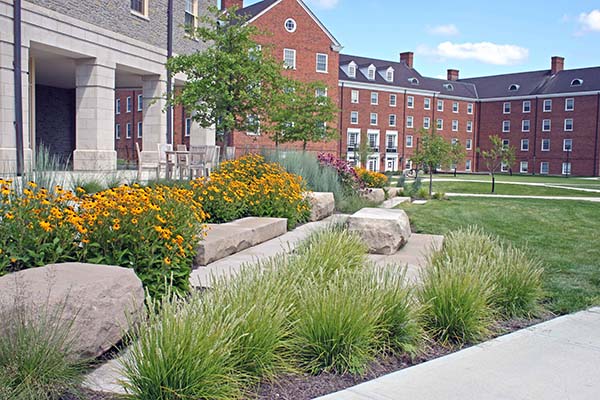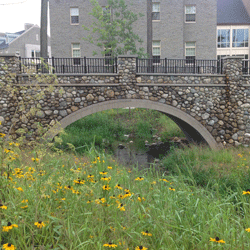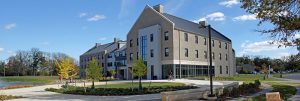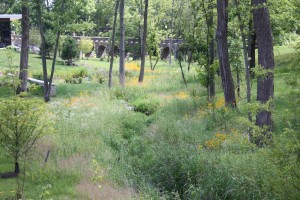Kleingers awarded ‘Cincinnati Design Award’ for work at Miami

For the second year in a row, The Kleingers Group was the proud recipient of a Cincinnati Design Award in the landscape architecture category.
This year, Kleingers won the honor award for its work on Miami’s western campus.

The goal of the Cincinnati Design Awards is to recognize high-quality design in the regional community and to educate the general public about the benefits of supporting quality design. Kleingers was honored to be listed among the top designers in the region.
“We really enjoyed working with Miami and the project team and are really pleased with how well it all came together,” said Lynne Nischwitz, Kleingers’ Landscape Architecture Studio Leader. “We were especially proud of how the hardscape and softscape weave together and thought it was really spectacular that we were able to expand the University’s Horticulture Walk.”
At the event, the judges thanked Kleingers for creating such a pleasing landscape.
The project began in 2014 when the University constructed three new residence halls, a dining hall, a geothermal energy plant, and two ponds.
The University’s vision for the Western campus landscape was to create a cohesive, naturalistic, and sustainable landscape that would immerse students into nature. Kleingers worked closely with the University to bring the vision to life.
The final design expanded the University’s horticulture walk, provided a central large gathering space, passive gathering spaces for each residence hall, pedestrian connections across campus, stream restoration, and the new 150’ long bridge that will look like the historic, iconic cobblestone bridges that have existed on this portion of Miami’s Western campus for many years.

The landscape and hardscape spaces ‘weave together’ such that colorful naturalistic plantings danced into plaza areas while these plaza areas disintegrated into beautiful swathes of planting colors and textures. The interplay of movement between the prairie-style landscape and the hardscape plazas and walks unifies the entire Western campus landscape and indulges students and visitors in nature’s beauty.
Each area of the design was carefully thought out and plays a part in fulfilling the University’s vision.
New Plantings
The extensive and unique plant list includes native trees, ornamental grasses, and perennials that provide seasonal bloom and sweeping, dramatic, and naturalistic views. These plantings were extremely important to the University as they allowed for the expansion of the University Horticulture Walk.
Plantings include over 50 types of trees and a vast array of perennials and grasses. Trees included many Oak varieties such as Bur Oak, Sawtooth Oak, White Oak, Overcup Oak, Chinkapin Oak, Willow Oak, and Shingle Oak, as well as Shagbark Hickory, Dawn Redwood, Sycamore, Hardy Rubber Tree, Katsuratree, Cottonwood, Gingko, Black Tupelo, Amur Corktree as well as multiple Maple varieties to name a few. Ornamental grasses included Little Bluestem, Ice Dance Carex, Northern Sea Oats, and Autumn Moor Grass and perennials included Coneflower, Blazing Star, Russian sage, and Salvia and Sedum varieties.
Stream Restoration
The detailed design of the stream restoration creates dramatic views from the new and historic pedestrian bridges by creating pools of water in-between stream riffles. The naturalistic plantings along the stream contribute to the overall low maintenance field of native prairie grasses with pops of color. Boulders of varying colors were utilized at different points along the stream and positioned along strategic portions of the pond edge to further unify the western campus aesthetic and create rhythm with the architecture.

Large Gathering Spaces
The central large gathering space consists of a sunken lawn oval with amphitheater seating that diminishes into the ground, further enhancing the seamless transition of hardscape and softscape. This central gathering space provides the opportunity for organized concerts or casual use, allows for zero edge handicap accessible entry into the sunken ‘green’, and marries the hardscape and the residence hall architecture through rings of blue/black seeded aggregate that radiate out from the ‘central green’ oval and continue through the buildings and out into separate passive outdoor patio spaces.
Reviewed by a blind jury from all over the country, Kleingers was extremely honored to be recognized for its work creating a natural, cohesive and sustainable landscape.